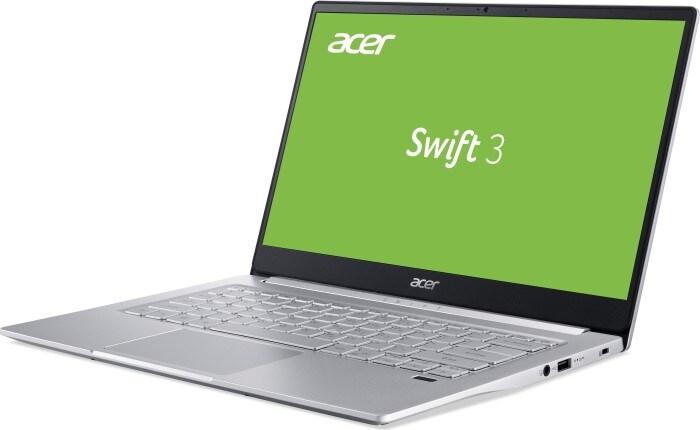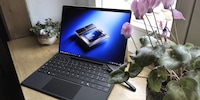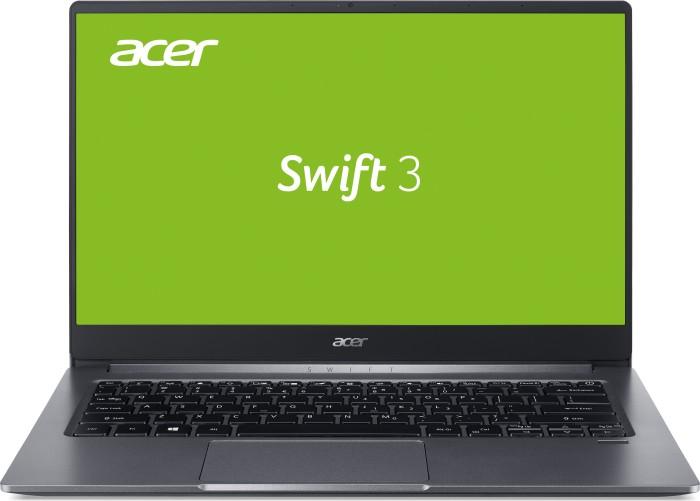

Acer Swift 3 tested: AMD vs. Intel
The Acer Swift 3 is available in two versions. The notebooks look identical, but differ on the inside in one important aspect: the processor. This comes from either Intel or AMD. I'll explain which variant you should choose here.
For years, AMD's Ryzen processors felt like they were being ignored. This changed at the end of 2019 with the fourth generation. It is said to have not only caught up with Intel's tenth generation of Core i CPUs, but even left them behind. And what better test than two notebooks that are identical apart from the chipsets and the integrated SoC (system-on-a-chip). Even if you are not interested in the Acer Swift 3, the results of the test may be of help to you. You can now also choose between AMD or Intel internals for more and more notebook models from other manufacturers.
The most important specs of the two devices at a glance:
| AMD version (SF314-41-R3C6) | Intel version (SF3-14-57-50BR) | |
|---|---|---|
| Processor | Ryzen 5 4500U | Core i5-1035G1 |
| Graphics chip | AMD Radeon 6 Graphics (Renoir) | Intel UHD Graphics (Ice Lake G1) |
| Working memory | 8 GB LPDDDR4 | 8 GB LPDDDR4 |
| Data storage | 512 GB SSD PCIe3x4/NVMe | 512 GB SSD PCIe3x4/NVMe |
| Display | 14 inch, 1920×1080 pixels | 14 inch, 1920×1080 pixels |
| Connections | Fingerprint sensor
1x USB 2.0 1x USB 3.0 Type A 1x USB3.1 Type C (Gen 2) 1x 3.5mm audio 1x HDMI | Fingerprint sensor
1x USB 2.0 1x USB 3.0 Type A 1x USB3.1 Type C (Gen 2) - Thunderbolt 3 1x 3.5mm audio 1x HDMI |
| WLAN | 802.11ax (WiFi 6) | 802.11ax (WiFi 6) |
| Bluetooth | 5.0 | 5.0 |
| Accu | 48 Wh (Li-Ion) | 48 Wh (Li-Ion) |
| Operating system | Windows 10 Home | Windows 10 Home |
| Dimensions (W x L x H) | 32.3 cm x 21.9 cm x 1.66 cm
1202 grammes | 31.9 cm x 21.7 cm x 1.59 cm
1129 grammes |
A look at the table makes it clear: apart from the motherboard and SoC, these are two identical notebooks. The fact that the AMD version is slightly larger and heavier is irrelevant for the hardware assessment.
Case, display and connections
Don't be fooled by the slightly different colouring. The casing of both Swift 3 models is made of aluminium. It feels robust and light at the same time. I can't find any flaws in the workmanship. This also applies to the matte IPS display with LED backlighting. It measures 14 inches and has a resolution of 1920×1080 pixels. That's enough for a high level of detail given the size. I am satisfied with the colour reproduction, but it should not meet any higher demands. It's easy to use indoors, but when the sun shines on it, you can hardly see anything on the screen. Side notes: The bezel around the display is a few millimetres thicker on the AMD version - which is suggested by the slightly larger casing.
The connectivity is almost identical, even if it is arranged differently. You can expect a USB 2.0 Type A, USB 3 Type A, USB 3.1 Type C Gen 2, HDMI and a 3.5 mm port. This means that all important standard connections are available. The difference can be found in the USB-C socket, which supports Thunderbolt on the Intel Swift and not on the AMD version.
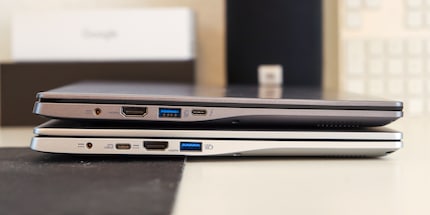
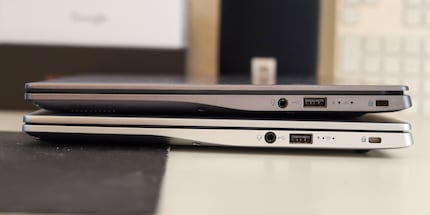
What really counts: The inner values
Enough about the exterior, this is mainly about the inner values. And that's where two different SoCs compete against each other: AMD Ryzen 5 4500U vs. Intel Core i5-1035G1.
Processor and graphics chip: The smaller, the better
A look at the data sheets reveals several differences in the processors. The Intel Core i5-1035G1 has four cores clocked at 1.00 GHz and can reach up to 3.6 GHz in turbo mode. It supports hyperthreading and therefore has eight threads and is manufactured using the 10-nanometre process. The AMD Ryzen 5 4500U has six cores, which are clocked at a higher 2.3 GHz and can reach up to 4 GHz in turbo mode. However, it does not support hyperthreading and therefore only has six threads. On the other hand, it is manufactured using the 7-nanometre process. This is important, as chips work more efficiently the smaller their transistors are.
If you want to get off the subject of terms like hyperthreading, my colleague Martin Jud has found a nice way to describe it: "You have an Intel processor with four humans (cores) that are slightly weaker than other creatures. But the four humans can operate two cranks at the same time and therefore perform more tasks in parallel. If it weren't for an AMD processor with six oxen, each of which only drives one crank, but with significantly more power."
Each of the SoCs comes with its own integrated graphics chip. Here, the AMD Radeon 6 Graphics can also score points with a 7-nanometre process compared to the 10-nanometre process of the Intel UHD Graphics (Ice Lake G1). In addition, the AMD graphics unit has a significantly higher clock frequency of up to 1.5 GHz. Intel's chip only has 0.3 GHz and up to 1.05 GHz when Turbo is active.
Benchmarks
Enough theory. Now it's time for practice - or at least simulated practice. I run several test programmes on both Acer Swift 3s
Geekbench
Geekbench lets both the processor and the graphics chip perform various calculations and outputs a numerical value at the end, which represents the performance of the system. While the performance of the processor is measured with one or more cores, the older "OpenCL" and the newer "Vulkan" interface are available for the graphics benchmark.
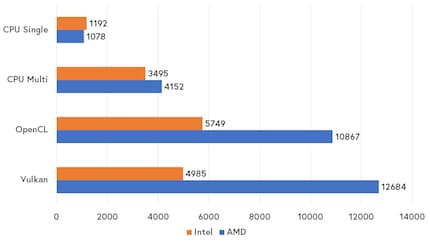
The CPU benchmark does not yet provide a clear result. The Swift 3 with Intel CPU is ahead in single mode. 1192 points are a small lead over the AMD CPU with 1078 points. Things look different in multi mode. The AMD chipset leaves the Core i5 behind with 4152 points compared to 3495 points.
The differences in performance are even clearer with the graphics chips. The AMD graphics chip dominates the Intel GPU with both OpenCL - 10,867 versus 5749 points - and Vulkan - 12,684 versus 4985 points.
Cinebench R20
Cinebench R20 is a benchmark based on a programme for creating 3D content and shapes called "Cinema 4D Suite". In multi-core mode, Cinebench accesses all CPU cores and makes great use of hyperthreading. In single mode, this is irrelevant. The result is clear: regardless of whether one or all computing cores are required, the AMD variant comes out on top.

With one computing core, the score is 424 to 399 points, and when all computing cores are used, the AMD Ryzen's lead increases to 1947 to 1103 points - even though the Intel Core i5 with hyperthreading should actually have an advantage here.
PCMark 10
PCMark tests the notebooks with a wide range of tasks. The overall result and three partial results are given at the end. The "Essentials" include things like launching applications, video calls and web browsing. In the "Productivity" section, the tool tests spreadsheets and text writing, among other things. The "Digital Content Creation" section includes photo and video editing and rendering, for example.
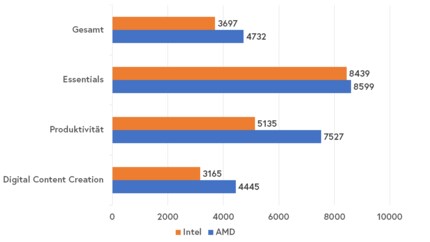
In terms of essentials, both versions of the Swift 3 are still on a par. Put simply, you won't notice any difference in your free time. However, when it comes to employees, you will make faster progress with the AMD version of the notebook - at least if you need its computing power. The Intel version performs worse in terms of both productivity and content creation.
SiSoftware Sandra
Sandra from SiSoftware is an analysis tool for PCs and also assigns index values for systems. For the Swift 3, Sandra supports the results of the other benchmark tests. Overall, the AMD variant is better. The lead is small for the CPU, but all the clearer for the graphics hardware. The computer performance index is 2.39 kPT to 1.95 kPT, the processor performance index is 3.56 kPT to 3.34 kPT and the hardware accelerator performance index is 2.58 kPT to 1.61 kPT.
The results of the benchmarks are not just grey theory, but have noticeable effects in everyday life. Not yet when booting up the computer, but already when starting programmes. What is only a difference of around one second for the Firefox browser quickly adds up to several seconds of waiting time for other programmes. This time saving with the AMD variant continues when these programmes have to perform more complex calculations.
Same battery, different runtimes
Both Swift 3s have the same lithium-ion battery with a capacity of 48 watt hours. Only the hardware from AMD and Intel ensures different battery runtimes. So turn up the screen brightness, switch off the power-saving settings and start a long YouTube video - after all, I don't want to wait forever. Conversely, this also means that you get even longer battery runtimes with power-saving behaviour.
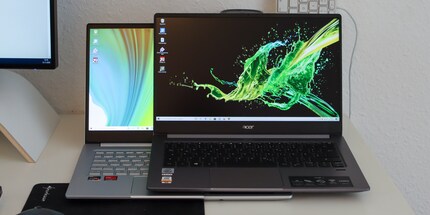
The result is clear: while the screen of the Swift 3 with Intel CPU went out after just 5:40 hours, the AMD variant ran significantly longer. It only finished after 9:09 hours. Almost exactly 3.5 hours more battery life just due to the chipset.
Conclusion: AMD wins
If you have the choice, you should go for AMD hardware. More performance, lower price and longer battery life. That's all there is to it. This should not only apply to the Swift 3 from Acer, but also to notebooks from other manufacturers. I haven't noticed a single disadvantage of AMD chips compared to Intel chips. If you know of any, let me know in the comments.
In autumn 2020, Intel unveiled its eleventh generation of processors, and a tenth-generation processor was tested here. However, the new Tiger Lake chips are still manufactured using the 10-nanometre process. So it doesn't look as if AMD's advantages will disappear in the short term. Only when Intel also switches to 7 nanometres will the race become exciting again.
When I was but a young student, I'd sit in my friend's living room with all my classmates and play on his SuperNES. Since then I've had the opportunity to test out all the newest technology for you. I've done reviews at Curved, Computer Bild and Netzwelt, and have now arrived at Galaxus.de.
